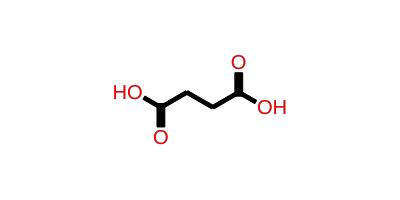- Resources
Recent Activities
Plants Gallery
Downloads
Worldwide, there are plants known as psychoactive plants that naturally contain psychedelic active components. They have a high concentration of neuroprotective substances that can interact with the nervous system to produce psychedelic effects. Despite these plants' hazardous potential, recreational use of them is on the rise because of their psychoactive properties. Early neuroscience studies relied heavily on psychoactive plants and plant natural products (NPs), and both recreational and hazardous NPs have contributed significantly to the understanding of almost all neurotransmitter systems. Worldwide, there are many plants that contain psychoactive properties, and people have been using them for ages. Psychoactive plant compounds may significantly alter how people perceive the world.
Compound Summary
CAS ID |
N/A |
||
INCHI KEY |
KDYFGRWQOYBRFD-UHFFFAOYSA-N |
||
MOLECULAR WEIGHT |
118.09 |
||
MOLECULAR FORMULA |
C4H6O4 |
||
MOLECULAR MASS |
118.088 |
||
BIOLOGICAL SOURCE |
Cistanche deserticola |
||
DATA SOURCE |
Afendi, F. M., Okada, T., Yamazaki, M., Hirai-Morita, A., Nakamura, Y., Nakamura, K., Ikeda, S., Takahashi, H., Altaf-Ul-Amin, M., Darusman, L. K., Saito, K., & Kanaya, S. (2012). KNApSAcK family databases: integrated metabolite-plant species databases for multifaceted plant research. Plant & cell physiology, 53(2), e1. https://doi.org/10.1093/pcp/pcr165 | ||
CHEMICAL CLASS OF COMPOUND |
Carboxylic acids and derivatives |
||
NLRP3 DOCKING SCORE(Kcal/mol) |
-4.064 |
||
CANONICAL SMILES O=C(O)CCC(=O)O
|
|||
BIOACTIVITY REPORTED FOR NEURODEGENERATIVE DISEASES
No
|
|||
SYNONYMS |
succinic acid, butanedioic acid, 110-15-6, Amber acid, Asuccin, Dihydrofumaric acid, Wormwood acid, Katasuccin, Bernsteinsaure, 1,2-Ethanedicarboxylic acid, ethylenesuccinic acid, 1,4-Butanedioic acid, Wormwood, Succinicum acidum, Butandisaeure, Acidum succinicum, Butanedionic acid, Kyselina jantarova, Butane diacid, Ethylene dicarboxylic acid, acide succinique, Bernsteinsaure [German], Bernsteinsaeure, Kyselina jantarova [Czech], HSDB 791, acide butanedioique, MFCD00002789, NSC 106449, UNII-AB6MNQ6J6L, AB6MNQ6J6L, AI3-06297, EINECS 203-740-4, succ, NSC-106449, BRN 1754069, DTXSID6023602, E363, FEMA NO. 4719, CHEBI:15741, HOOC-CH2-CH2-COOH, DTXCID303602, EC 203-740-4, 4-02-00-01908 (Beilstein Handbook Reference), NSC25949, 1,2 Ethanedicarboxylic Acid, NCGC00159372-02, NCGC00159372-04, Succinellite, Sal succini, WLN: QV2VQ, SUCCINIC ACID (II), SUCCINIC ACID [II], SIN, SUCCINIC ACID (MART.), SUCCINIC ACID [MART.], Succinic Acid; Butanedioic acid, Ethylene succinic acid, Ethanedicarboxylic acid, butandisaure, succinic-acid, sodium succinate (anhydrous), SUCCINIC ACID (USP IMPURITY), SUCCINIC ACID [USP IMPURITY], succinate, 9, CAS-110-15-6, ADIPIC ACID IMPURITY B (EP IMPURITY), ADIPIC ACID IMPURITY B [EP IMPURITY], Succinic acid [NF], Succinic acid (8CI), 1,4 Butanedioic Acid, Butanedioic acid (9CI), Dihydrofumarate, Succinicate, Butanedioic acid diammonium salt, 1cze, 1,4-Butanedioate, Succinic acid, 6, Succinic acid, FCC, Succinic Acide,(S), SuccinicAcid(IndustrialGrade&FoodGrade), Succinic acid, 99%, Succinic acid, natural, 4lh2, 1,2-Ethanedicarboxylate, suc, Succinic acid, ACS grade, bmse000183, bmse000968, CHEMBL576, SUCCINIC ACID [MI], SUCCINIC ACID [FCC], A 12084, SUCCINIC ACID [HSDB], SUCCINIC ACID [VANDF], GTPL3637, SUCCINIC ACID [USP-RS], SUCCINIC ACID [WHO-DD], SUCCINICUM ACIDUM [HPUS], BDBM26121, Succinic acid (Butanedioic acid), HMS3885O04, HY-N0420, STR02803, Tox21_111612, Tox21_201918, Tox21_303247, BBL002473, LMFA01170043, NSC-25949, NSC106449, s3791, STK387105, Succinic acid, >=99%, FCC, FG, Succinic acid, BioXtra, >=99.0%, AKOS000118899, Tox21_111612_1, 1ST7504, CCG-266069, DB00139, NCGC00159372-03, NCGC00159372-05, NCGC00159372-06, NCGC00257092-01, NCGC00259467-01, Succinic acid, ACS reagent, >=99.0%, BP-21128, Succinic acid, ReagentPlus(R), >=99.0%, CS-0008946, NS00002272, S0100, Succinic acid, p.a., ACS reagent, 99.0%, Succinic acid, SAJ first grade, >=99.0%, EN300-17990, Succinic acid, purum p.a., >=99.0% (T), Succinic acid, SAJ special grade, >=99.5%, 1,4-BUTANEDIOIC ACID (SUCCINIC ACID), C00042, D85169, SBI-0633499.0002, Succinic acid, Vetec(TM) reagent grade, 98%, AB01332192-02, Q213050, SR-01000944556, J-002386, SR-01000944556-2, BRD-K45238818-001-02-6, Z57127453, F2191-0239, 37E8FFFB-70DA-4399-B724-476BD8715EF0, Succinic acid, certified reference material, TraceCERT(R), Succinic acid, puriss. p.a., ACS reagent, >=99.5% (T), matrix substance for MALDI-MS, inverted exclamation markY99.5%(T), Succinic acid, United States Pharmacopeia (USP) Reference Standard, InChI=1/C4H6O4/c5-3(6)1-2-4(7)8/h1-2H2,(H,5,6)(H,7,8, Succinic acid, matrix substance for MALDI-MS, >=99.5% (T), Ultra pure, Succinic acid, anhydrous, free-flowing, Redi-Dri(TM), ACS reagent, >=99.0%, Succinic acid, BioReagent, suitable for cell culture, suitable for insect cell culture, Succinic Acid, Pharmaceutical Secondary Standard; Certified Reference Material, 26776-24-9 |
||
